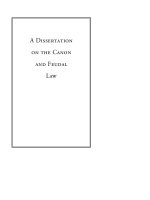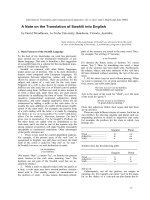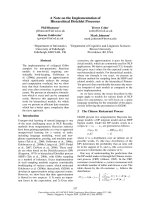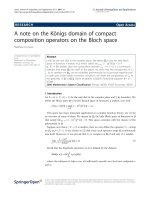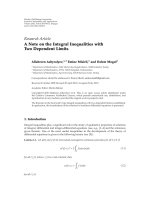A note on the p−center problem
Bạn đang xem bản rút gọn của tài liệu. Xem và tải ngay bản đầy đủ của tài liệu tại đây (66.02 KB, 6 trang )
Yugoslav Journal of Operations Research
21 (2011), Number 2, 199-204
DOI: 10.2298/YJOR1102199J
A NOTE ON THE
P − CENTER
PROBLEM
Nader JAFARI RAD
Department of Mathematics, Shahrood University
of Technology, Shahrood, Iran
Received: February 2010 / Accepted: November 2011
Abstract: The p - center problem is to locate p facilities in a network so as to minimize
the longest distance between a demand point and its nearest facility. In this paper, we
give a construction on a graph G which produces an infinite ascending chain
G = G0 ≤ G1 ≤ G2 ≤ ... of graphs containing G such that given any optimal solution X
for the p - center problem on G , X is an optimal solution for the p - center problem on
Gi for any i ≥ 1 .
Keywords: Location theory, p - center problem.
MSC: 90B80, 05CXX.
1. INTRODUCTION
Network location problems are concerned with finding the right locations to
place one or more facilities in a network of demand points, i.e., customers represented by
nodes in the network, that optimize a certain objective function related to the distance
between the facilities and the demand points. Usually, the facilities to be located are
desirable, i.e., customers prefer to have the facilities located as close to them as possible.
For example, services such as police and fire stations, hospitals, schools, and shopping
centers are typical desirable facilities.
The p-center problem is to locate p facilities in a network so as to minimize the
longest distance between a set of n demand points and the p facilities. This problem is
central to the field of location theory and logistics, and has been subject to extensive
research. For references in p-center problem see for example [1-11].
200
N. J. Rad / A Note On The P − center Problem
We model the network as a graph G = (V , E ) , where V = {v 1 ,v 2 ,...,v n } is the
vertex set with V = n and E is the edge set with E = m . We assume that the demand
points coincide with the vertices, and restrict the location of the facilities to the vertices.
Each vertex v 1 has a weight w1 and the edges of graph have positive weights. Let
d (u ,v ) is the length of shortest weighted path between vertices u and v . In the P −
center problem we want to find a subset X ⊆ V of cardinality p such that the maximum
weighted distances from X to all vertices is minimized. In other words, we want to find
a subset X ⊆ V of cardinality p such that F (X ) = max w i d (X ,v i ) is minimized.
i =1,..., n
We call a graph G triangle-free if G does not contain any triangle as an
induced subgraph. Triangle-free graphs are a class of well-studied graphs and play an
important role in graph theory. Many of graph theory parameters deal with triangle-free
graphs. To see some results on triangle-free graphs we refer the reader to look for
example [12]. Yet determining location problems in triangle-free graphs is open.
One of the questions regarding location problems is how to nontrivially extend a
graph G to a larger graph with the same optimal solution for the p - center problem. We
will present a nontrivial construction. We give a construction on a graph G which
produces an infinite chain G = G0 ≤ G1 ≤ G2 ≤ ... of graphs containing G such that for a
given optimal solution X for the p - center problem on G , X is an optimal solution for
the p - center problem on G i for any i ≥ 1 . If G has n vertices and m edges, our
construction produces a graph M (G ) with 2n vertices and 2m edges. Furthermore if
G is triangle-free, then M (G ) is triangle-free. Note that by Gi ≤ G j we mean that Gi is
a subgraph of G j . This construction produces bigger and bigger graphs (instances) which
have the same optimal solution as the original graph G . This allows us to extend a graph
with the given optimal solution for p - center problem to a bigger graph without any
further calculation to find a solution for p -center problem.
All graphs handled in this paper are connected and undirected. We recall that the
open neighborhood of a vertex υ in a graph G is denoted by N (v ) or N G (v ) to refer
to G , thus N (v ) = {u ∈V uv ∈ E } . Also, note that by ”optimal solution”, we mean a
best possible solution for our problem. So if X and Y are two optimal solutions for the
p - center problem and F is the objective function, then F ( X ) = F (Y ) .
2. MAIN RESULT
We first give a construction as follows. Let G = (V , E ) be a weighted graph
with a vertex set V = {v 1 ,v 2 ,...,v n } . For i = 1, 2,..., n , let wi be the weight of v i . Also,
for e ∈ E , let a(e) be the weight of e . Our construction produces an M - graph M (G )
from G with V (M (G )) = V ∪ U where U = {u1 ,..., u n } and
N. J. Rad / A Note On The P − center Problem
201
E (M (G )) = E (G ) ∪ {u i v : v ∈ N G (v i ), i = 1,..., n }
The weights of new vertices and new edges of M (G ) are the following. For
i = 1, 2,..., n the weight of v i is equal to wi , and for a new edge e = v i v j the weight of
e is equal to the weight of v i v j . We define the k -th M -graph of G , recursively by
M 0 (G ) = G and M k +1 (G ) = M ( M k (G )) for k ≥ 1 . We shall prove the following.
Theorem 1. Assume that G is a weighted graph where all vertices have the same weight
and all edges have the same weight. Let X be an optimal solution for the p -center
problem on G . For any positive integer k , X is an optimal solution for the p-center
problem on M k (G ) .
Proof. Let G = (V , E ) be a weighted graph with a vertex set V = {v 1 ,v 2 ,...,v n }
where all vertices have the same weight w , and all edges have the same weight a. It is
sufficient to prove the theorem for k = 1 since the result follows by induction. Let
M (G ) be the M-graph obtained from G with V (M (G )) = V ∪ U where
U = {u1 ,..., u n } and E (M (G )) = E (G ) ∪ {u i v : v ∈ N G (v i ), i = 1,..., n } .
Thus for i = 1, 2,..., n , the weight of the new vertex v i is w , and for a new edge
e the weight is a . For a vertex z ∈ V ( M (G )) \ V (G ) we let v z ∈V (G ) be the vertex
which is N M (G ) (v z ) = N M (G ) (z ) .
Let X = { x1 , x2 ,..., x p } ⊆ V be an optimal solution for the p − center problem
on G , and let y ∈ V (G )\X be a vertex such that d G ( y , X ) = max d G (v , X ) = d . It
v ∈V (G )\X
follows that d M (G ) ( y , X ) = max d M (G ) (v , X ) = d . Let Y be an optimal solution for
v ∈V (G )\X
the p − center problem on M (G ) . We prove that
max
v ∈V ( M (G ))\Y
d M (G ) (v ,Y ) = d . Let
z ∈ V ( M (G ))\Y be a vertex such that
d M (G ) (z ,Y ) =
max
v ∈V ( M (G ))\Y
d M (G ) (v ,Y ).
We consider the following cases.
Case 1. Y ⊆ V (G ) and z ∈V (G ) . Then Y is a solution for the p − center
problem on G . Since X is an optimal solution for the p − center problem on G , we
obtain dG ( z , Y ) ≥ dG ( y, X ) . This implies that d M (G ) ( z , Y ) ≥ d M (G ) ( y , X ) . But Y is an
optimal solution for the p − center problem on M (G ) . Thus d M (G ) ( z , Y ) ≥ d M (G ) ( y, X ) .
Case 2. Y ⊆ V (G ) and z ∉V (G ) . If v z ∈Y , then d M (G ) ( z , Y ) ∈ {wa, 2 wa} .
N. J. Rad / A Note On The P − center Problem
202
Let u ∈ V ( M (G ))\V(G) be a vertex such that u ∉ Y and
Then d M (G ) (u, Y ) = wa. This implies that d M (G ) ( z , Y ) = wa.
N G (v u ) ∩Y ≠ 0/ .
But d M (G ) ( y, X ) = dG ( y, X ) ≥ wa . We deduce that d M (G ) ( y, X ) = d M (G ) ( z, Y ) = wa. Thus
we may assume that u z ∉ Y . Then d M (G ) (z ,Y ) = d M (G ) (v z ,Y ) . Now the result follows
from Case 1.
Case 3. Y ⊆/ V (G ). If for any u ∈V (M (G ))\V(G), {u,vu } ∩Y ≤ 1, then
Y ′ = (Y ∩V (G )) ∪ {v u : u ∈ (V (M (G ))\V(G)) ∩ Y}
is a solution for the p-center
problem on M (G ) with
max
v ∈V ( M (G ))\Y
d M (G ) (v ,Y ) =
max
v ∈V ( M (G ))\Y ′
d M (G ) (v ,Y ′),
and the result follows from Cases 1 and 2. So we assume that there is some vertex
u ∈ V ( M (G ))\V(G) such that {u ,υu } ⊆ Y . Let
A = {u ∈V (M (G ))\V(G):{u,v u } ⊆ Y
}
and let y0 be a vertex such that
d M (G ) ( y 0 ,Y ) =
max
v ∈V ( M (G ))\Y
d M (G ) (v ,Y ) .
Without loss of generality assume that y0 ∈ V (G ) . Let y1 ∈ Y be a vertex with
d M (G ) ( y0 , Y ) = d M (G ) ( y0 , y1 ). Consider a vertex u1 ∈ A . Let v u * be a vertex in V (G )\Y
1
such that
d M (G ) ( y 0 ,v u * ) ≥ d M (G ) ( y 0 ,Y 1 )
1
{ }
and let Y 1 = (Y \ { u1}) ∪ u 1* . Then d M (G ) ( y0 , Y ) = d M (G ) ( y0 , Y1 ) = d M (G ) ( y0 , y1 )
so Y1 is an optimal solution for the p − center problem on M (G ) . Let u2 ∈ A\ {u1} .
Then, let v u * be a vertex in V (G )\Y1 such that
2
d M (G ) ( y 0 ,v u * ) ≥ d M (G ) ( y 0 , y 1 ) .
2
Then
{ }
Y 2 = (Y 1 \ { u 2 }) ∪ u 2*
is an optimal solution for the p − center problem on M (G ) . By continuing this process,
Y A is an optimal solution for the p − center problem on M (G ) . Since Y A ⊆ V (G ) , the
result follows from Cases 1 and 2.
Now the result follows by induction.
N. J. Rad / A Note On The P − center Problem
203
We remark that Theorem 1 does not work if the weight of vertices and edges of
G are different. To check this, let G be a path P3 with vertices v 1 ,v 2 ,v 3 , and edges
v 1 ,v 2 and v 2 ,v 3 . Let w (v 1 ) = w (v 3 ) = 1,w (v 2 ) = 2 , and the weight of each edge be 1.
Then X = {v 2 } is an optimal solution for the 1-center problem on G , and F ( X ) = 1 .
Now, V (M (G )) = {v 1 ,v 2 ,v 3 ,u1 , u 2 , u 3 } where the weight of each edge is one and
i = 1, 2,3, w (u i ) = w (v i ) . It is easy to see that Y = {v 1} is an optimal solution for the 1-
center problem on M (G ) and F (Y ) = 2 , while F (X ) = F ({v 2 }) = 4 .
3. CONCLUSION
Our construction produces an infinite ascending chain G = G0 ≤ G1 ≤ G2 ≤ ... of
graphs containing G such that given any optimal solution X for the p − center problem
on G , X is an optimal solution for the p − center problem on Gi for any i ≥ 1 . This
allows us to extend a graph to a sufficiently bigger graph with no more calculation
required to find an optimal solution for p − center problem. Further, if G is a graph on
n vertices and m edges, then for any positive k ≥ 1 , M k (G ) is a graph with 2k n vertices
and 2k m edges. Hence, if f (G ) is the complexity function for the p − center problem
on a graph G , then
lim
k →∞
f (G )
=0
f ( M k (G ))
REFERENCES
[1]
[2]
[3]
[4]
[5]
[6]
[7]
[8]
Bespamyatnikh, S., Bhattacharya, B., Keil, M., Kirkpatrick, D., and Segal, M., “Efficient
algorithms for centers and medians in interval and circular-arc graphs”, Networks, 39 (2002)
144-152.
Drezner, Z., and Hamacher, H., Facility Location: Applications and Theory, Springer- Verlag,
Berlin, 2002.
Frederickson, G., “Parametric search and locating supply centers in trees”, Proceedings of
Workshop on Algorithms and Data Structures, (1991) 299-319.
Goldman, A.J., “Optimal center location in simple networks”, Transportation Sci., 5 (1971)
212–221.
Hassin, R., and Tamir, A., “Improved complexity bounds for location problems on the real
line”, Operation Research Letters, 10 (1991) 395–402.
Hua, L.K., et al. “Applications of mathematical methods to wheat harvesting”, Chinese
Mathematics, 2 (1962) 77–91.
Kariv, O., and Hakimi, S.L., “An algorithmic approach to network location problems. Part I:
the p-centers.” SIAM J. Appl. Math., 37 (1979) 513-538.
Kariv, O., and Hakimi, S.L., “An algorithmic approach to network location problems.Part II:
p-medians”, SIAM J. Appl. Math., 37 (1979) 539–560.
204
[9]
N. J. Rad / A Note On The P − center Problem
Lan, Y.F., Wang, Y.L., and Suzuki, H., “A linear-time algorithm for solving the center
problem on weighted cactus graphs”, Information Processing Letters, 71 (1999) 205-212.
[10] Mirchandani, P.B., and Francis, R., Discrete Location Theory, J.Wile, 1990.
[11] Tamir, A., “Improved complexity bounds for center location problems on networks by using
dynamic data structures”, SIAM Journal of Discrete Mathematics, 1 (1988) 377-396.
[12] West, D.B., Introduction to Graph Theory, (2nd edition), Prentice Hall, USA, 2001.

